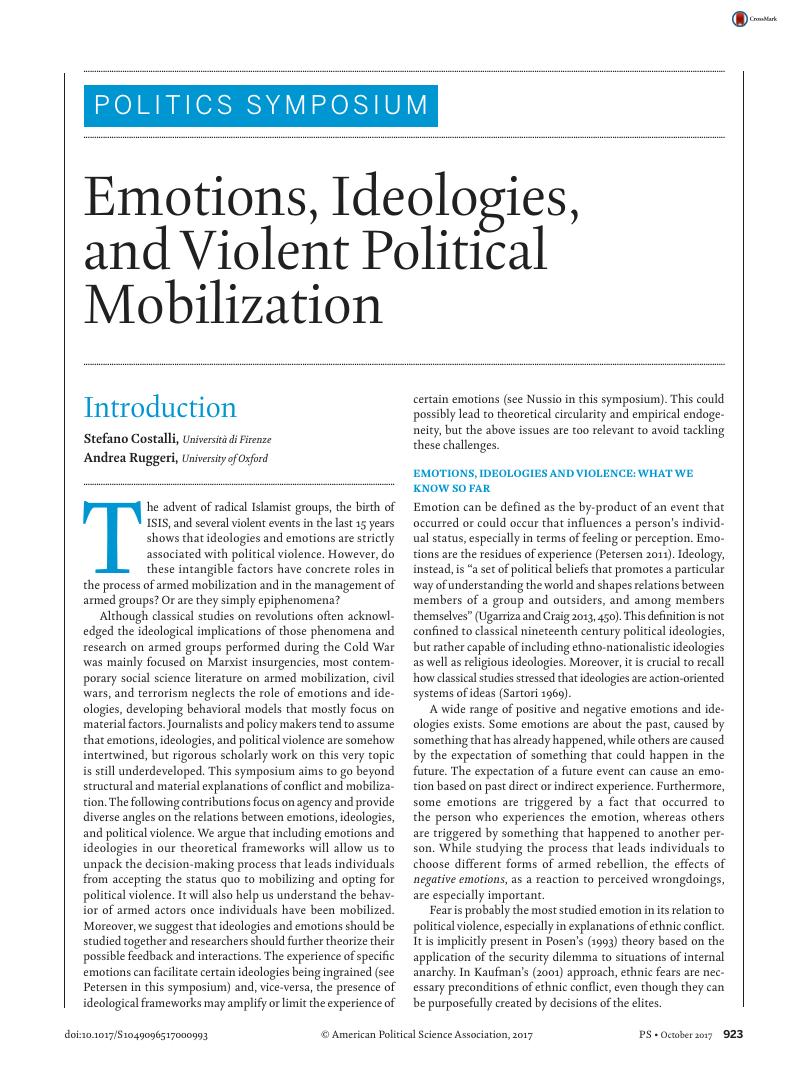Crossref Citations
This article has been cited by the following publications. This list is generated based on data provided by Crossref.
Söderström, Johanna
2018.
Fear of Electoral Violence and its Impact on Political Knowledge in Sub-Saharan Africa.
Political Studies,
Vol. 66,
Issue. 4,
p.
869.
Leader Maynard, Jonathan
2019.
Ideology and armed conflict.
Journal of Peace Research,
Vol. 56,
Issue. 5,
p.
635.
Cederman, Lars-Erik
Hug, Simon
Schubiger, Livia I.
and
Villamil, Francisco
2020.
Civilian Victimization and Ethnic Civil War.
Journal of Conflict Resolution,
Vol. 64,
Issue. 7-8,
p.
1199.
Alter, Karen J
and
Zürn, Michael
2020.
Conceptualising backlash politics: Introduction to a special issue on backlash politics in comparison.
The British Journal of Politics and International Relations,
Vol. 22,
Issue. 4,
p.
563.
Parkinson, Sarah E.
2021.
Practical Ideology in Militant Organizations.
World Politics,
Vol. 73,
Issue. 1,
p.
52.
Masullo, Juan
2021.
Civilian Contention in Civil War: How Ideational Factors Shape Community Responses to Armed Groups.
Comparative Political Studies,
Vol. 54,
Issue. 10,
p.
1849.
Shesterinina, Anastasia
2022.
Civil war as a social process: actors and dynamics from pre- to post-war.
European Journal of International Relations,
Vol. 28,
Issue. 3,
p.
538.
Söderström, Johanna
and
Olivius, Elisabeth
2022.
Pluralism, temporality and affect – methodological challenges of making peace researchable.
Conflict, Security & Development,
Vol. 22,
Issue. 5,
p.
411.
Dahlum, Sirianne
Pinckney, Jonathan
and
Wig, Tore
2023.
Moral Logics of Support for Nonviolent Resistance: Evidence From a Cross-National Survey Experiment.
Comparative Political Studies,
Vol. 56,
Issue. 3,
p.
326.
Tripathi, R. C.
Kumar, Rashmi
Siddiqui, Roomana N.
Mishra, R. C.
and
Bano, Shabana
2023.
Ideological Frames and Reaction to Intergroup Norm Violations.
Psychology and Developing Societies,
Vol. 35,
Issue. 1,
p.
131.
Marone, Francesco
2025.
Spillover terrorism? Exploring the effects of the Israel-Hamas war on jihadist violence in Europe.
Journal of Contemporary European Studies,
p.
1.
Fink, Oliver
Hasan Aslih, Siwar
and
Halperin, Eran
2025.
Two paths to violence: Individual versus group emotions during conflict escalation in the Occupied Palestinian Territories.
Group Processes & Intergroup Relations,
Vol. 28,
Issue. 2,
p.
355.
Erkiletian, Sam A
2025.
The role of subgroup leaders in combatant socialization and resocialization: The British re-education program for German POWs (1946–1948).
Journal of Peace Research,
Vol. 62,
Issue. 4,
p.
1205.
Söderström, Johanna
Holdo, Markus
and
Junman, Alice
2025.
Uncomfortable interviews: A research journey of discomfort and how to make the most of it.
Qualitative Research,
Vol. 25,
Issue. 5,
p.
1041.


